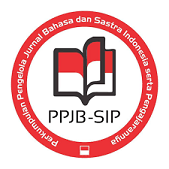ALIH KODE DAN CAMPUR KODE GURU DALAM PEMBELAJARAN BAHASA INDONESIA KELAS VII SMP NEGERI 4 KUBUTAMBAHAN
DOI:
https://doi.org/10.23887/jjpbs.v4i2.8141Abstract
Penelitian deskriptif kualitatif ini dilakukan dalam pembelajaran Bahasa Indonesia di kelas VII SMP N 4 Kubutambahan dengan tujuan untuk: 1) mendeskripsikan jenis alih kode yang dilakukan guru dalam interaksi pembelajaran; 2) mendeskripsikan jenis campur kode yang dilakukan guru dalam interaksi pembelajaran; 3) mendeskripsikan faktor-faktor yang menyebabkan guru melakukan alih kode; 4) mendeskripsikan faktor-faktor yang menyebabkan guru melakukan campur kode; dan 5) mendeskripsikan pengaruh alih kode dan campur kode terhadap pemahaman siswa. Metode yang digunakan adalah observasi dan wawancara. Hasil penelitian ini menunjukkan: 1) jenis alih kode yang dilakukan guru adalah alih kode ke dalam; 2) campur kode yang dilakukan guru adalah campur kode ke dalam dan ke luar; 3) faktor-faktor yang melatarbelakangi guru melakukan alih kode adalah keinginan guru mengimbangi kemampuan berbahasa siswa, memberikan pujian kepada siswa, menegur atau memberikan nasihat, menghidupkan suasana belajar agar tidak tegang, dan kebiasaan guru menggunakan bahasa Bal; 4) faktor-faktor yang melatarbelakangi guru melakukan campur kode adalah penekanan pada kata-kata tertentu, ketidaksadaran guru, keterbatasan bahasa Indonesia, dan kesederahanaan struktur bahasa lain merupakan faktor penyebab guru melakukan campur kode kode; 5) pengaruh positif alih kode dan campur kode guru terhadap pemahaman siswa adalah lebih mudah memahami materi, sedangkan dampak negatifnya adalah dapat mengurangi proses pemerolehan bahasa Indonesia siswa dan dapat menyebabkan pemborosan waktu.Kata Kunci : alih kode, campur kode, pembelajaran Bahasa Indonesia
This deskriptive qualitative study was done inIndonesian learning at VII grade students of SMP N 4 Kubutambahan with aims to: 1) describe the types of code switching done by the teacher learning interaction; 2) to describe types of code mixing done by the teacher learning interaction; 3) to describe the factors of code switching done by the teacher; 4) to describe the factors of code mixing done by the teacher; and 5) to describe the influence of code switching and code mixing to the students’ understanding learning. The method used observation and interview. The results of this study showed: 1) code switching done by the teacher was inner code switching; 2) code mixing done by the teacher was inner and outer code mixing; 3) the factors of code switching were to offset the students’ language skill, to give feedback, to give warning and advice, to cheer up the situation in the classroom, and teacher’s habit to use Balinese; 4) the factors of code mixing were the emphasis on certain words, teacher’s unconsciousness, limitation of Indonesian, and the simplicity of other language structure were the factors of code mixing done by the teacher; 5) The positive influence of code switching and code mixing to students’ understanding were the easily students understood the materials meanwhile the negative impact was it could decrease the students’ language acquisition process and it could waste time.
keyword : code switching, code mixing, Indonesian learning
Published
2016-08-01
Issue
Section
Articles
License
Authors who publish with the Jurnal Pendidikan Bahasa dan Sastra Indonesia Undiksha agree to the following terms:- Authors retain copyright and grant the journal the right of first publication with the work simultaneously licensed under a Creative Commons Attribution License (CC BY-SA 4.0) that allows others to share the work with an acknowledgment of the work's authorship and initial publication in this journal
- Authors are able to enter into separate, additional contractual arrangements for the non-exclusive distribution of the journal's published version of the work (e.g., post it to an institutional repository or publish it in a book), with an acknowledgment of its initial publication in this journal.
- Authors are permitted and encouraged to post their work online (e.g., in institutional repositories or on their website) prior to and during the submission process, as it can lead to productive exchanges, as well as earlier and greater citation of published work. (See The Effect of Open Access)







